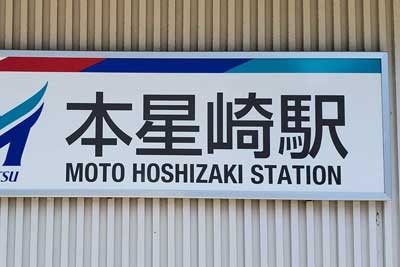2022.06.28

On the west side of the Meitetsu Nagoya Line in Minami Ward, just before it crosses the Tempaku and Ogi rivers into Midori Ward, are a number of adjoining areas sharing the name Hoshizaki (Hoshizaki 1-chome and 2-chome, Hoshizaki-cho, and Moto Hoshizaki-cho), and serviced by Moto Hoshizaki Station.
星
hoshi (star; planet; heavenly body)
崎
saki / zaki (cape; promontory; small peninsula)
The 崎 / zaki part of the name suggests that the area was once coastline, which may be difficult for present-day visitors to imagine given that the area is a few kilometers inland from the waters of Nagoya Port and Ise Bay. But this character serves as a reminder of local topography before the extensive land reclamation that has taken place as the port and surrounding areas developed.
星 / hoshi will probably evoke visions of starry skies that local residents and travelers may have enjoyed there in the days before industrialization. But rather than the spectacle of the Milky Way, the 'star' may actually refer to meteorites that are said to have fallen in the area.

Hoshinomiya Shrine
In 635, during the reign of Emperor Jomei (629-641), a comet is said to have appeared, and a subsequent drought that year resulted in many deaths. A falling 'star' two years later caused something of a flurry, and the villagers are said to have built the Hoshinomiya Shrine (星宮社) to enshrine the fallen celestial object. Given its location at what was then the southernmost point of a promontory, the shrine lanterns lit by the villagers are said to have also served as beacons for water faring vessels.
In 1632, villager Murase Rokubee is said to have been extracting salt from seawater when he heard a tremendous noise and saw a fireball fall from the sky. The meteorite was passed down through generations of the Murase family, and donated to Yobitsugi Shrine (喚續神社) in 1892, and has ever since been enshrined as an important treasure of the shrine. Known as the Minamino Meteorite (南野隕石), an analysis carried out in 1976 confirmed the rock's extraterrestrial origins, making it the second oldest confirmed meteorite discovered in Japan.

Yobutsugi Shrine




